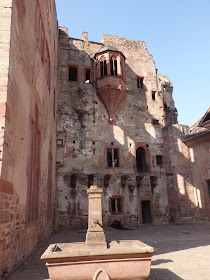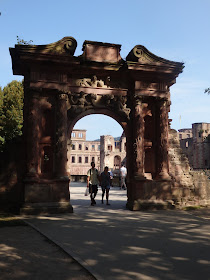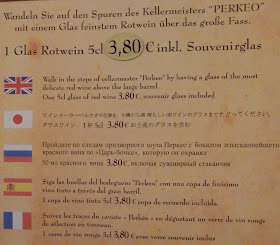 |
| Straight from Wikipedia, "Heidelberg Castle ( German: Heidelberger Schloss) is a ruin in Germany and landmark of Heidelberg. The castle ruins are among the most important Renaissance structures north of the Alps. The castle has only been partially rebuilt since its demolition in the 17th and 18th centuries. It is located 80 metres (260 ft) up the northern part of the Königstuhl hillside, and thereby dominates the view of the old downtown. It is served by an intermediate station on the Heidelberger Bergbahn funicular railway that runs from Heidelberg's Kornmarkt to the summit of the Königstuhl. The earliest castle structure was built before 1214 and later expanded into two castles circa 1294; however, in 1537, a lightning-bolt destroyed the upper castle. The present structures had been expanded by 1650, before damage by later wars and fires. In 1764, another lightning-bolt caused a fire which destroyed some rebuilt sections." |
 |
| Picture of Schloss Heidelberg from Wikipedia |
 |
| This is our Program Director Randy as he told us the story of the gate. |
 |
| This is the back of the gate that she saw from her window. Not such a pretty gift. |
 |
| Photos of the ruins |
 |
| View of the city of Heidelberg from the front of the ruins. |
 |
| View of Old Bridge (Alte Brücke - 1786-88), where it crosses the Neckar River. |
 |
| Looking down into the moat. It's really deep. |
 |
| We entered the inner courtyard through this arched door |
 |
| Looking up you could see the points of the portcullis. The portcullis is a strong, heavy grating that slides up and down in vertical grooves which is lowered to block a gateway to a fortress. |
 |
| Entering the courtyard. |
 |
| Every king of the castle had buildings constructed. The contractor on this building insisted his two little boys be allowed to come to work with him. |
 |
| They fell to their deaths one day so this decoration over the door is a memorial to them. |
 |
| One of the Renaissance Wings built by Elector Otto-Heinrich is covered in statues. |
 |
| There's a sundial on this tower. |
 |
| Closer shot of sundial |
 |
| Well head |
 |
| The other Renaissance Wings built by Elector Otto-Heinrich. Of the original three stories, only the bottom one is intact. |
 |
| The following photos are of the statuary on the façade. |
 |
| David with Goliath's head |
 |
| This tree was just so lovely up next to the red blocks of the wall. |
 |
| Closer shot of foliage and flowers. |
 |
| Side of the castle facing the river. |
 |
| Looking out at the Old Bridge again. |
 |
| One of the towers surrounding the patio |
 |
| Then we were off to the wine cellar. This wine "barrel" is over 12' tall. Absolutely huge. |
 |
| ....this is. The largest wine cask in the world! It is 28.7 feet long and 23 feet in diameter. It held 58,573 US gallons. We walked up and over it but that's a waste of time. |
 |
| The Castle went though a few wars. At the end of the Nine Years War, the French set fire to it and blew the front off the Fat Tower. |
 |
| Our bus took us back to the Main Street of Heidelberg. Heidelberg is a college town and this is one of the students drinking spots. |
 |
| You'll have to click to enlarge this photo with information about the city. |
 |
| Marktplatz |
 |
| Because of the angle of the sun, it was hard to get a photo of the castle from Marktplatz. |
 |
| Sculpture in Marktplatz. |
 |
| Sculpture by the Church of the Holy Spirit. |
 |
| Our lunch in Heidelberg. Yummy! |
 |
| As we were wandering the street, this pizza delivery vehicle sped by us. It is a college town so I'm sure the pizza places get a lot of business. |
 |
| The walls of the jail are filled with the incarcerated stundents’ writings, images, and portraits. |
 |
| They even covered the bottom of the steps. |
 |
| The toilet. I wonder how they handles dividing the sexes since the university went co-ed in 1899. |
 |
| Back out at the old bridge, we see another one of those monkeys showing us a mirror. |
 |
| The bus hauled us all back to our ship docked at Rudesheim. |
 |
| The crew had been filling our water tanks while we were gone. |
 |
| Lemon pie with blueberry sauce. Such a pretty presentation. |






















No comments:
Post a Comment